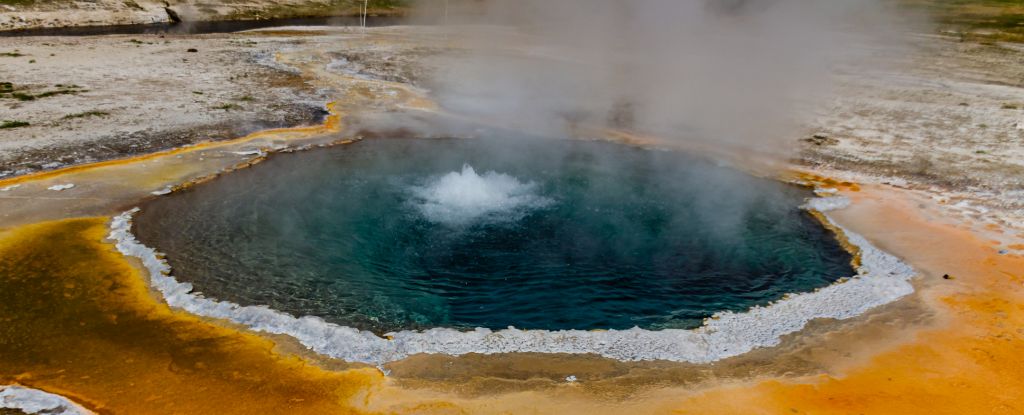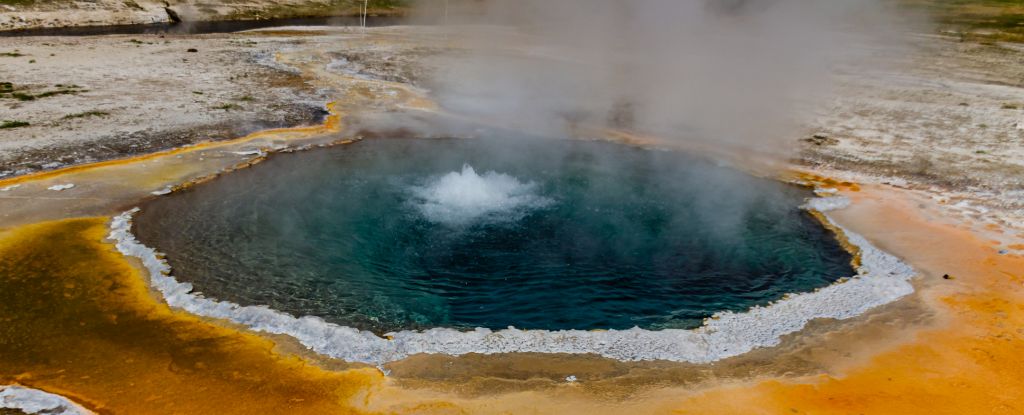
Yellowstone’s Rumbling Supervolcano Reveals a New Secret
Yellowstone National Park, renowned for its iconic Old Faithful geyser, serves as a constant reminder that it sits atop a massive, ever-shifting supervolcano. This dynamic geological landscape is in perpetual flux, with changes occurring both dramatically and subtly. A recent discovery has captured the attention of scientists and park visitors alike: a newly opened volcanic vent, caught in the act of releasing a plume of steam into the atmosphere. This finding underscores the park’s volatile nature and provides valuable insights into the hydrothermal activity simmering beneath the surface. What does this discovery mean for the future of Yellowstone, and what secrets does it hold about the Earth’s inner workings? How might this new vent affect the surrounding environment and the delicate balance of life that thrives in this unique ecosystem?
The initial clue to this phenomenon was a conspicuous steam plume, noticed in August 2024, where previously there had been none. A team of scientists embarked on a mission to investigate the plume’s origin and ascertain whether it signified the emergence of a new hydrothermal feature. The presence of this steam cloud sparked curiosity and prompted a closer examination of the area, ultimately leading to the identification of the vent. Where exactly is this vent located, and why did it take so long to detect it? What instruments and techniques were employed to determine its nature and origin? The answers to these questions shed light on the challenges and complexities of monitoring volcanic activity in a vast and remote wilderness.
Upon closer inspection, the team recorded a temperature of 77 degrees Celsius (171 Fahrenheit) at the vent and observed a delicate layer of gray siliceous clay. These observations confirmed that the vent was indeed newly formed. While the emergence of a new vent is noteworthy, experts emphasize that it doesn’t necessarily indicate a surge in overall hydrothermal activity. The vent is situated in the Roadside Springs area, which overlies a substantial hydrothermal zone fueled by the supervolcano lurking beneath Yellowstone. How does the supervolcano generate such intense heat, and what role does water play in transferring this heat to the surface? What are the potential hazards associated with hydrothermal activity, and how are they managed to ensure the safety of park visitors and infrastructure?
Roadside Springs Vent: Echoes of Past Hydrothermal Activity
The recent vent discovery bears resemblance to an event that occurred more than two decades ago, hinting at a possible connection between the two phenomena. On March 10, 2003, a similar instance of hydrothermal activity was documented on the opposite side of the same rhyolite lava flow, just west of Nymph Lake. Interestingly, this activity, although less intense now, persists to this day, as reported by the Yellowstone Volcano Observatory. Could these two locations be interconnected via an underground reservoir? The proximity of these events raises questions about the underlying geological structures and the potential for future hydrothermal manifestations. What lessons can be learned from the 2003 event, and how can they be applied to better understand and manage the current situation?
The possibility of an underground connection is further supported by a line of faults that extends from Norris Geyser Basin to the Mammoth Hot Springs, potentially linking the 2003 and 2024 vents. This alignment suggests a shared plumbing system beneath the surface, where hydrothermal fluids can migrate and manifest in different locations. Understanding the intricacies of this underground network is crucial for predicting future eruptions and assessing the overall volcanic hazard in Yellowstone. How do scientists track the movement of these fluids, and what tools do they use to map the subsurface geology?
The behavior of the new vent seems to mirror that of its predecessor. Initially, it emitted a dense plume of steam that lingered throughout the fall, gradually diminishing as winter approached. Although the vent remains active, its steam emissions have significantly decreased. The future evolution of this vent and the information it reveals about the underlying region are the focus of ongoing monitoring efforts. What specific parameters are being monitored, and what data are being collected to track the vent’s activity? How will this information be used to refine our understanding of Yellowstone’s complex hydrothermal system?
Unveiling Yellowstone’s Secrets: A Hotspot for Science
Yellowstone’s subterranean realm is a hive of activity, making it a prime location for scientific exploration. The park is not only a volcanic hotspot but also a treasure trove of scientific discovery. Microorganisms thriving in its toxic hot springs provide insights into the extraordinary adaptations that life can make to survive in extreme environments. These extremophiles offer clues about the origins of life on Earth and the potential for life beyond our planet. How do these organisms thrive in such harsh conditions, and what unique biochemical pathways do they employ? What can we learn from them about the limits of life and the possibilities for extraterrestrial existence?
Furthermore, Yellowstone is often subject to intense seismic activity and sporadic, unpredictable explosions, serving as a constant reminder of the powerful forces at play beneath the surface. Scientists speculate that the vast magma reservoir under the park is also in motion, adding another layer of complexity to the region’s dynamic nature. These phenomena provide invaluable data for understanding volcanic processes and improving our ability to forecast eruptions. What are the triggers for these earthquakes and explosions, and how are they related to the movement of magma? What are the long-term implications of a shifting magma reservoir, and what are the potential consequences for the surrounding area?
Experience Yellowstone’s Wonder Safely
Yellowstone National Park is truly a natural wonder, an experience that should be on everyone’s bucket list. The park’s unique geological features, diverse ecosystems, and abundant wildlife offer an unparalleled opportunity to connect with nature and witness the power of the Earth firsthand. However, it’s essential to remember that Yellowstone is also a potentially hazardous environment, and visitors should always exercise caution and be aware of their surroundings. What are some essential safety tips for visiting Yellowstone, and how can visitors minimize their risk of encountering hazards such as geysers, hot springs, and wildlife? By respecting the park’s natural forces and following safety guidelines, visitors can enjoy a memorable and enriching experience while ensuring their well-being.
